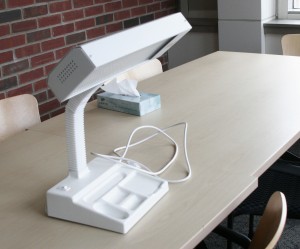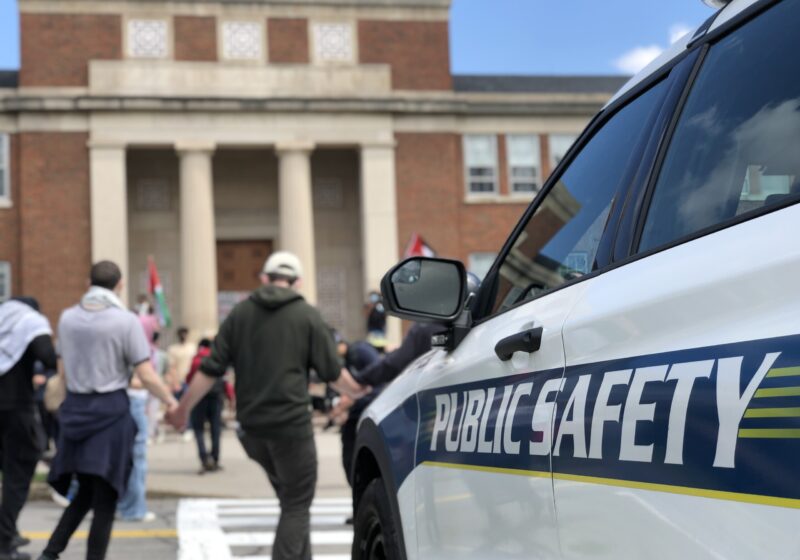
Drue Sokol, Photo Editor
The last leaf on a giant, white oak falls slowly to the ground and eventually croaks while tree branches — dormant in the harsh bitter cold — remind students of winter’s deathly toll. The days shorten as the sun gradually disappears behind a growing wall of clouds, gray skies define the landscape and time drags on. This oppressive climate may often cause UR students to suffer from a common form of depression called Seasonal Affective Disorder (SAD), and one possible cure — light therapy — lies within the University Counseling Center (UCC). Sadly, though, not many people take advantage of it.
Last year, Rochester was declared the snowiest city in the United States with an average accumulation of 99.5 inches — enough snow to burst through the ceiling of a one-story room. This record amount of snow leads to another superlative: most days of snowfall. For 66 days on average, the city of Rochester falls prey to clouded skies and falling white snowflakes.
All of this snow may evoke images of a winter wonderland to many, but those who endure the precipitation firsthand know that it has a dark side. Rochester is among the top 20 cities that receive the least amount of sunshine each year — a figure especially relevant during the overcast winters.
Together, these three statistics create the trifecta of gloom. Months on end with little to no sunlight, frigid temperatures producing nonstop snow and constant wind chills create an environment that students can often barely tolerate.
“Some days you just want to see the sun,” sophomore Andrew Keene said. “It gives you hope.”
Unfortunately, Mother Nature doesn’t respond to pleas of hope and there are times when the sun remains obscured by clouds for days on end. While this happens, the average low temperature reaches a frigid 16 degrees in January, but the wind chill causes what feels like sub-zero temperatures.
Students like sophomore Colin McCoy, instead of begining their mornings afresh, often burrow in their beds and relish in the warmth of their comforter cocoons as opportunities pass them by.
“There are times where I don’t want to get out of bed,” McCoy said. “I don’t want to face the day.”
And so, Old Man Winter silently claims another victory.
For students experiencing symptoms of SAD, the urge to oversleep during the winter has a biological basis beyond laziness. The circadian rhythm — the body’s natural clock that controls sleep cycles — is dysfunctional and forces students to stay up past their desired bedtimes. The drastic alteration of sleeping patterns quickly infects other aspects of students’ lives and feelings of hopelessness often emerge. Other symptoms of SAD include decreased concentration and creativity, increased irritability, changes in appetite, a drop in energy levels and anti-social behavior.
Coping with SAD or a minor case of the winter blues is a daunting task for some students and a walk in the park for others. The majority of students make it through the winter with minor battle wounds and an occasional melancholy day, but others suffer and endure the pain for months because they are unaware that the disorder exists. Consequently, they don’t know that light therapy is an option or are skeptical of light therapy’s legitimacy.
Light therapy lamps activate photoreceptors in the retina by emitting a comparable amount of light to that absorbed by the eyes at high noon during the summer.
For 30 minutes every day, patients position the lamps slightly above eye level so the light can reach the bottom of the eyes. The lamps have a staggering effectiveness rate of 50 to 80 percent and patients begin to benefit from the positive effects in as little as one week of use.
One to two weeks of repeated use will normalize the body’s circadian rhythm and dispel the negative symptoms of winter depression.
Secretary Brenda Lawson is the first person to greet people who come to UCC, which is home to two light therapy lamps. Lawson explained that a grand total of nine students used the lamps during the 2010-11 academic year and five students have tried them this year.
The larger of UCC’s two lamps appears similar to a computer monitor and the smaller one resembles an ordinary desk lamp. Both lights are available to use, free of charge, whenever the conference room is unoccupied.
UCC administrator Karen Platt encouraged students to “come in and sit by the lights for an hour.”
However, students rarely take that advice.
“I have so much stuff going on,” Keene said. “I don’t have time to go all the way to UCC just to sit in front of a lamp for an hour.”
In the meantime, winter trudges on and students’ happiness is lost to gray skies. UCC keeps printing pamphlets, but recuperation must start from within the afflicted. If students affected by SAD are willing to make a 30-minute daily commitment, their lives may be forever changed. They can rise above the pervasive gloom and let the light into their lives.
Duncan is a member of the class of 2014.
